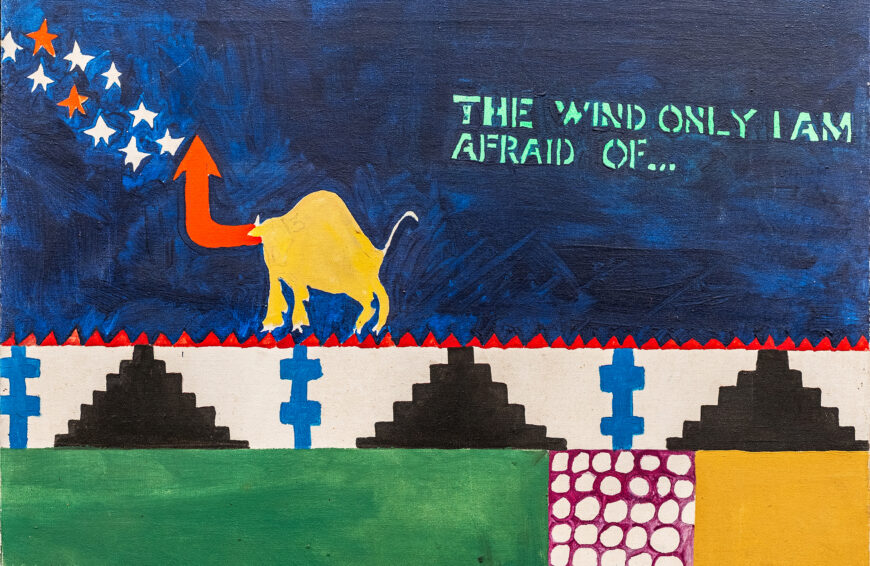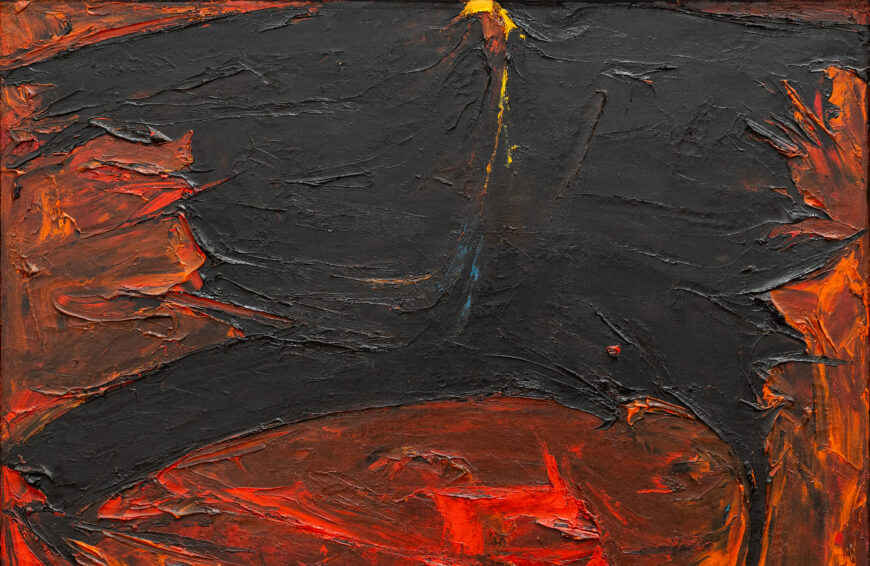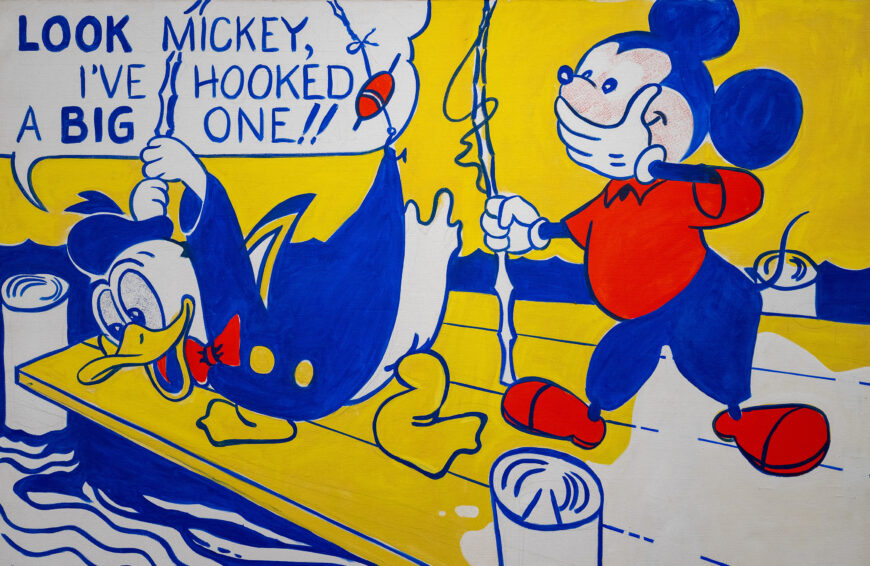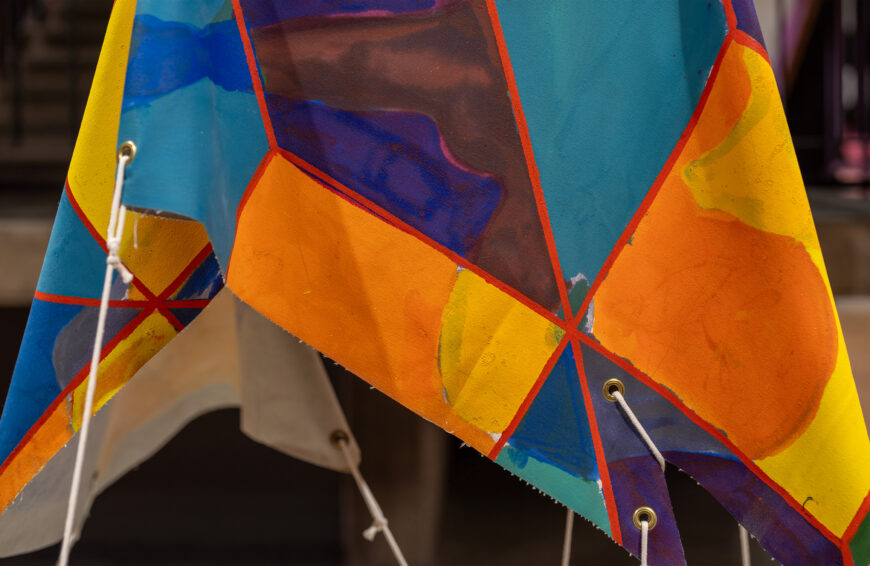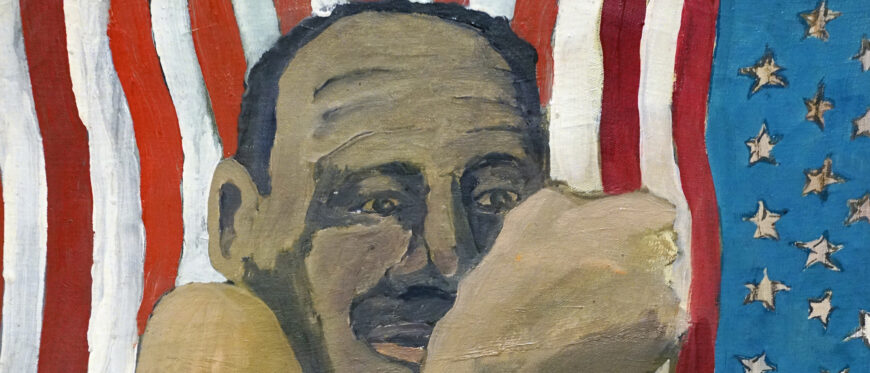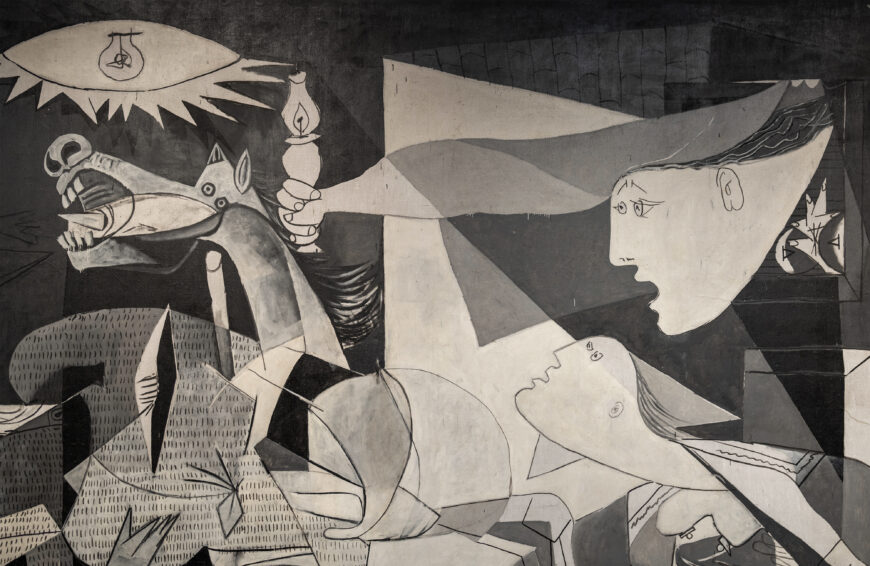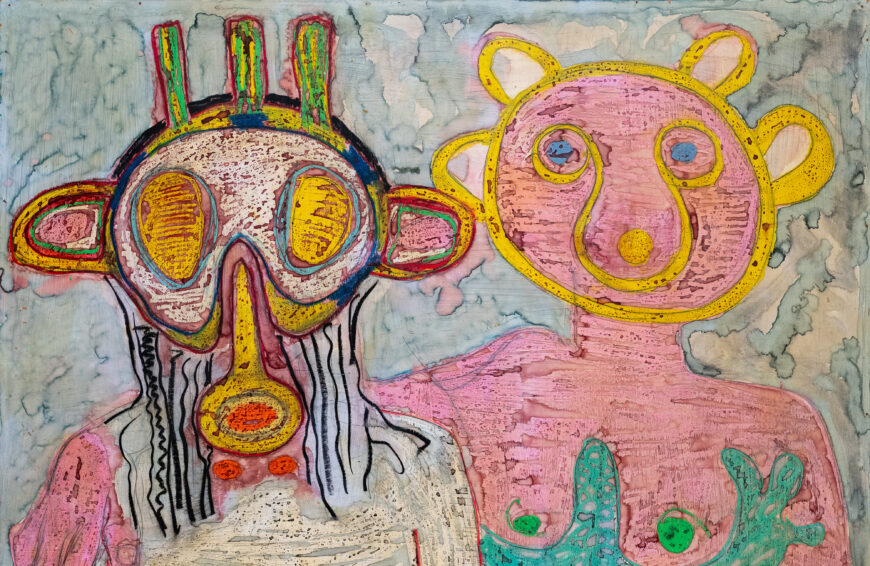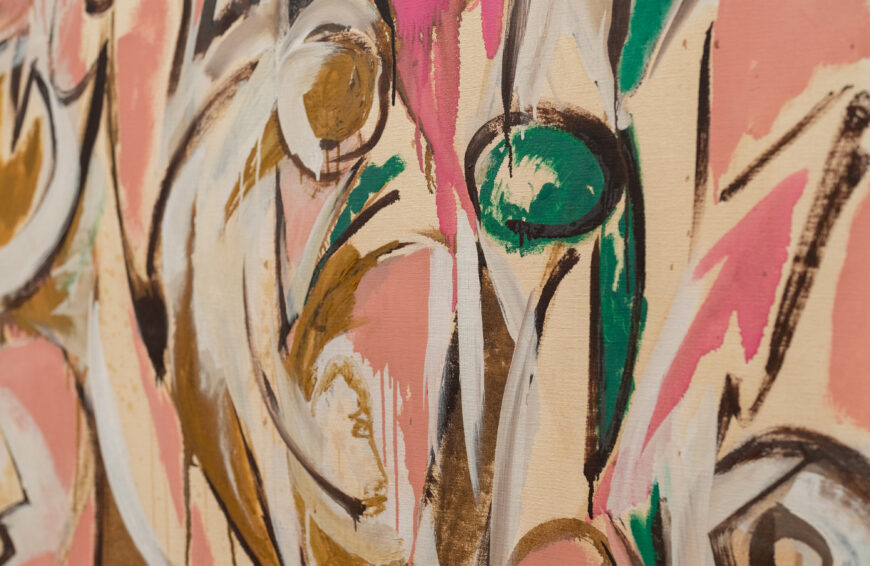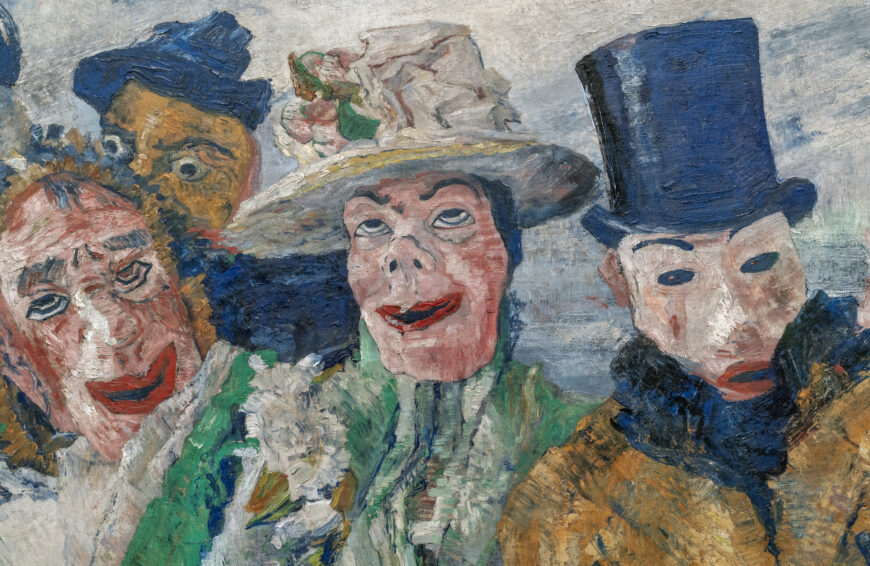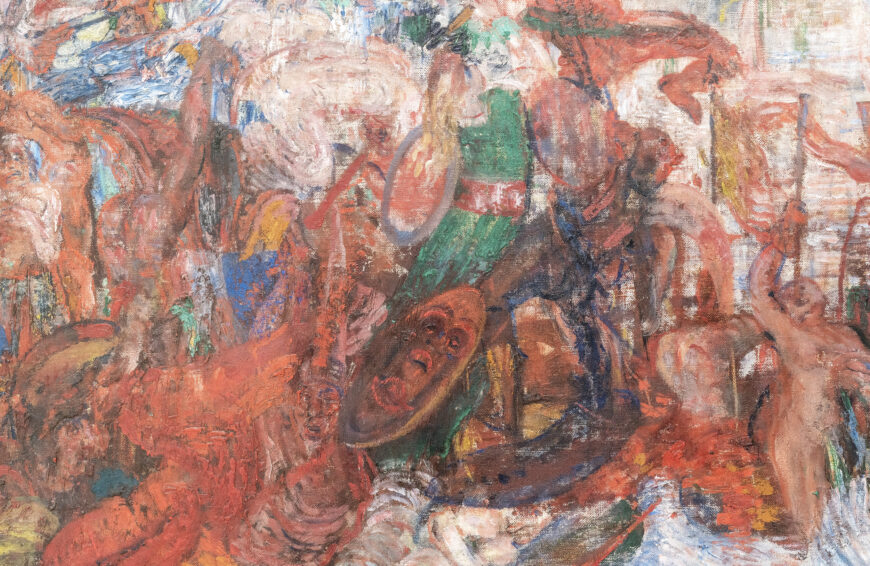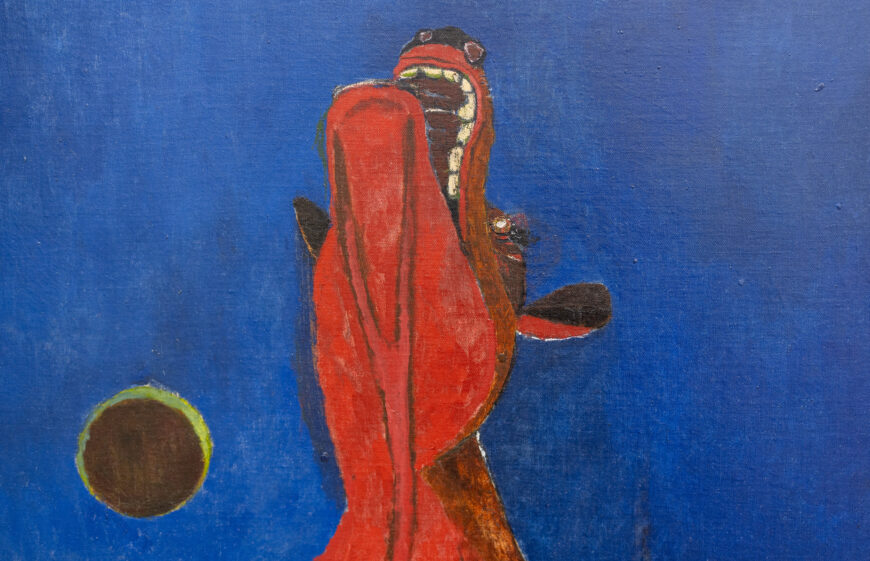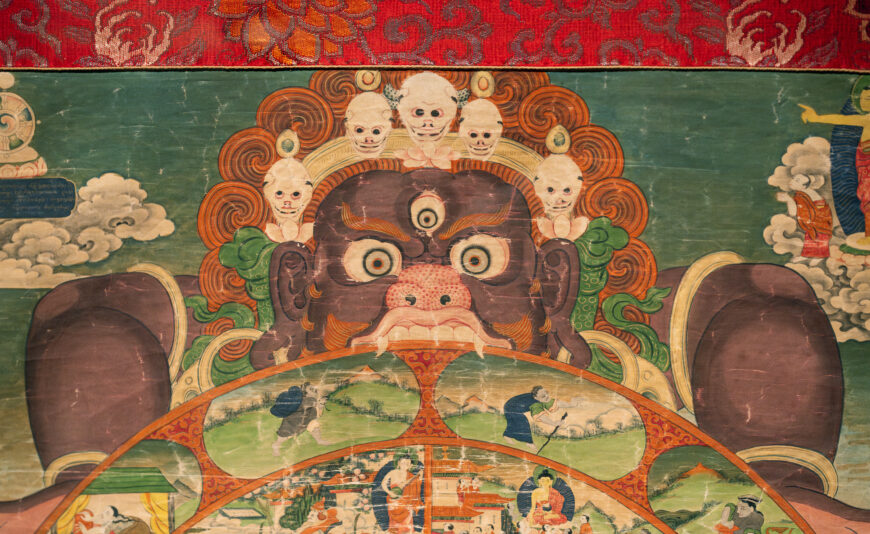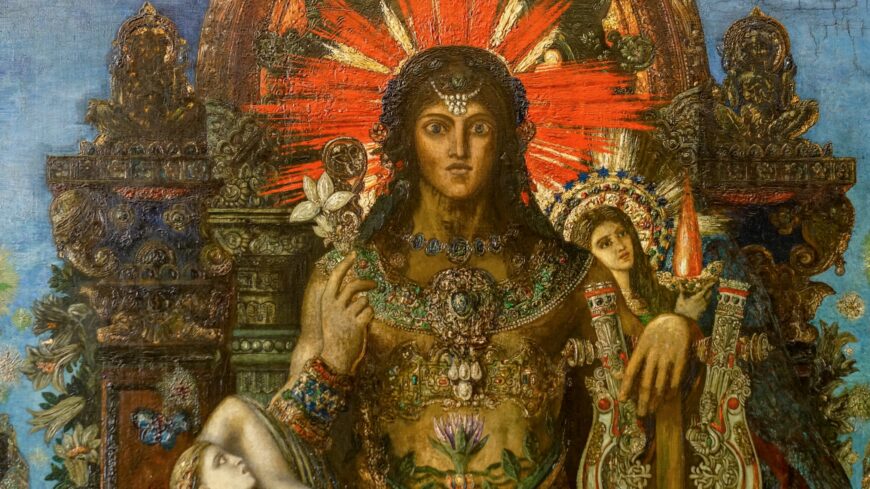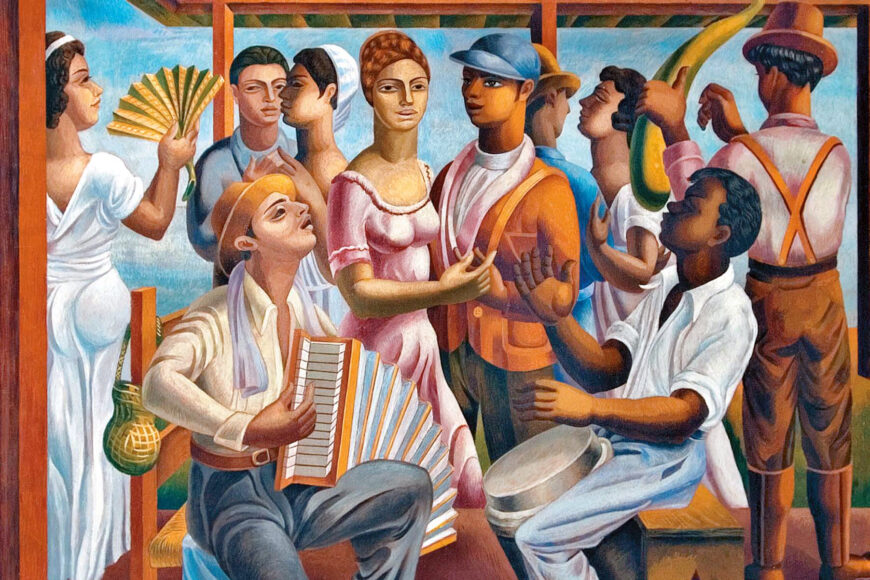Aaron Douglas, Aspiration, 1936, oil on canvas, 152.4 x 152.4 cm (Fine Arts Museums of San Francisco), a Seeing America video
Aaron Douglas, Aspiration
[0:00] [music]
President Franklin D Roosevelt: [0:30] My friends of Texas, I have come here today to bear the tribute of the nation to you on your 100th birthday. Oh, you are 100 years young.
Announcer: [0:35] And what a birthday party. A huge $25 million exhibition in Dallas with all Texas playing host.
Dr. Beth Harris: [0:32] We’re in the photo studio at the de Young Museum, part of the Fine Arts Museums of San Francisco, and we’re looking at a painting by an important early 20th-century artist, Aaron Douglas, called “Aspiration.”
Timothy Anglin Burgard: [0:44] Aaron Douglas’s first major commission was for the iconic publication, “The New Negro — An Interpretation” by Alain Locke. In those illustrations, he takes Alain Locke’s lead that African American artists should embrace their African heritage.
[1:02] Historically, Europeans had claimed the history of Africa in general, but especially Egypt, as the bedrock of European culture. Douglas and the other artists associated with the Harlem Renaissance were insistent that African Americans embrace this culture as their history.
Dr. Harris: [1:20] We do see the influence of ancient Egyptian art here in the profiles of the figures, in the way that their shoulders are turned frontally, and even the influence of African masks.
[1:31] But this painting had a very specific purpose. It was commissioned for the Texas Centennial Exposition of 1936 that commemorated Texas’ independence from Mexico, and for The Hall of Negro Life that, despite many obstacles, was created for that exposition.
Timothy: [1:51] “Aspiration” was one of a four-part mural depicting the history of early Texas, but very importantly, from an African American perspective.
[2:01] Two of the panels are lost, but the other extant panel shows Africans being taken into slavery, to a ship that will then cross the Atlantic in the Middle Passage. “Aspiration” is the other part of the story, here on the American side of the Atlantic.
Dr. Harris: [2:17] We see hands in bondage. We see the shackles of slavery around the wrists of these upraised hands.
Timothy: [2:24] And they are surrounded by these curvilinear, flowing waves. This represents the Middle Passage of ships across the Atlantic Ocean carrying their human cargo of enslaved Africans.
[2:37] Historians often point out if someone on these ships became ill, they were often thrown overboard because the slave traders didn’t want to endanger the rest of their human cargo. You see these arms upraised as if they are sinking beneath the waves, reaching upward for some kind of salvation.
Dr. Harris: [2:55] As we move up, we see three figures on a podium pointing to a city on the horizon.
Timothy: [3:01] The three-tiered plinth symbolizes the Old, Middle, and New Kingdoms of Egypt. Egypt was famous for its innovations in architecture, most famously the pyramids.
Dr. Harris: [3:12] We see those pyramids here in the fractured forms between the five-pointed stars. One female figure sits on the corner of that podium, holding a book in her right hand, leaning back, and looking up toward the city. Her face, her body, intersects that star.
Timothy: [3:29] This female figure, for Douglas, I think represents Mother Egypt. She is the font of African Egyptian history and culture. She holds the open books, the symbol of knowledge, and notice that the waves of the Middle Passage wash across her feet, just as the Nile River when it floods every spring washes across the temples along its shores.
[3:51] Her hair wig is a very typical symbol of that Egyptian culture, as is her purple color, which is a royal color. This introduces imagery of kingship, a symbol of pride for contemporary African Americans. The pose of Mother Egypt holding the open book is derived from a Renaissance source, Michelangelo’s Libyan Sybil in the Sistine Chapel in Rome.
[4:15] Sojourner Truth, one of the great freedom fighters against slavery, was known as the Libyan Sibyl. The two modern African Americans on the plinth embody new ideals of the Harlem Renaissance. The figure holding the right-angle square, the compass, and adjacent to the terrestrial or celestial globe might be Benjamin Banneker, a famous astronomer and mathematician.
[4:37] The man holding the beaker in the center might be George Washington Carver, who was an agricultural chemist. There are other associations for these two modern men who embodied the educated New Negro. There are three famous figures who might indeed have appeared upon a plinth or podium at this time.
[4:55] Among them are Jesse Owens, the American Olympian, Paul Robeson, the actor and singer, and Joe Louis, the champion boxer. Three real-life African American heroes who set an example for the rest of society of the kind of aspiration and achievement embodied in Douglas’ painting.
Dr. Harris: [5:15] That idea of being uplifted, of imagining a future where racial discrimination is no more must’ve been difficult to imagine in the segregated Jim Crow South of Texas, but still the sense of hope as the figures look up toward the upper-right corner of the composition.
Timothy: [5:33] Viewers always notice that the glowing, five-pointed stars point to the city on the hill in the distance. The star could be seen as the Lone Star State, Texas. The star was all over the fairgrounds in Dallas as a celebratory symbol of the dominant white culture.
[5:50] On the other hand, for an African American viewer, they would have seen that star as the North Star that led slaves out of slavery in the Deep South to freedom in the North. Not only do the stars radiate from Egypt but also circles.
[6:05] Douglas felt the greatest contribution of African American culture to the world was jazz. He likened the radiating circles to sound waves spreading African American culture around the world.
Dr. Harris: [6:18] On the opposite corner, a threat looms. We see lightning, we see clouds, and a darkness that the figures turn away from.
Timothy: [6:26] Douglas’ glowing and radiating stars seem to dispel the darkness. It’s not an easy path, but it is possible to triumph and transcend the evils of the past but also draw nurture from the great accomplishments of the past.
[6:42] When visitors entered the lobby of The Hall of Negro Life and cast their gaze upon Aaron Douglas’ four extraordinary murals, white visitors, the few that dared to enter The Hall of Negro Life, the segregated building on the periphery of the main fairgrounds, often challenged the attendant at the front desk, claiming that it was not possible that an African American artist could have created these murals.
[7:06] These queries were so numerous they actually had to post a sign stating, “These murals were painted by Mr. Aaron Douglas of New York, an African American artist.”
Dr. Harris: [7:18] I’m struck by the incredible optimism of the people who put together The Hall of Negro Life, writing a history to be able to imagine a future in America.
[7:29] [music]
| Title | Aspiration |
| Artist(s) | Aaron Douglas |
| Dates | 1936 |
| Places | North America / United States |
| Period, Culture, Style | Modernisms / Harlem Renaissance |
| Artwork Type | Painting |
| Material | Oil paint, Canvas |
| Technique |
See this object at the Fine Arts Museums of San Francisco
View Into Bondage, the other mural panel that survives from this project
Watch a promotional film about the 1936 Texas Centennial Exposition
Learn about the Hall of Negro Life and Douglas’s murals
Read the foreword to Alain Locke’s The New Negro: An Interpretation
Learn more about Sojourner Truth and read some of her speeches
Read about the life and career (beyond peanuts) of George Washington Carver
Watch a short video on Jesse Owens and the 1936 Olympics
Learn about the career and political activism of Paul Robeson
Read about the boxer Joe Lewis
Find out about the importance of the North Star to the Underground Railroad
Key points
- In 1936, Texas celebrated its independence from Mexico with the Texas Centennial Exposition in Dallas. Like many world’s fairs, it included pavilions and exhibitions by different groups, including the Hall of Negro Life, which traced Texas history from an African American perspective. The building was located on the periphery of the fairgrounds and demolished immediately after the end of the fair.
- Aaron Douglas was commissioned to paint four murals for the Hall of Negro Life, but only two survive today. His work reflected the philosophy of the Harlem Renaissance, influenced deeply by Alain Locke, who argued that African Americans should embrace and celebrate their African heritage.
- The artist combined elements of modern abstraction and traditions of Egyptian and European art to chronicle history from an African American perspective. While Douglas modeled his figures on Egyptian forms and Michelangelo’s Libyan Sibyl from the Sistine Chapel, he also used simple geometric shapes to suggest the Middle Passage, the North Star (which doubled as the Texas Lone Star), and jazz music.
- Using his characteristic silhouetted style, Aaron Douglas suggests specific references for the three figures on the podium, but leaves them open to more universal interpretations. For example, the seated woman can be understood both as both Mother Egypt and Sojourner Truth. The figures all represented the educated “New Negro,” speaking to the achievements and aspirations of African Americans in the early 20th century.
More to think about
If you were to paint the two missing panels, what subjects would you include?


